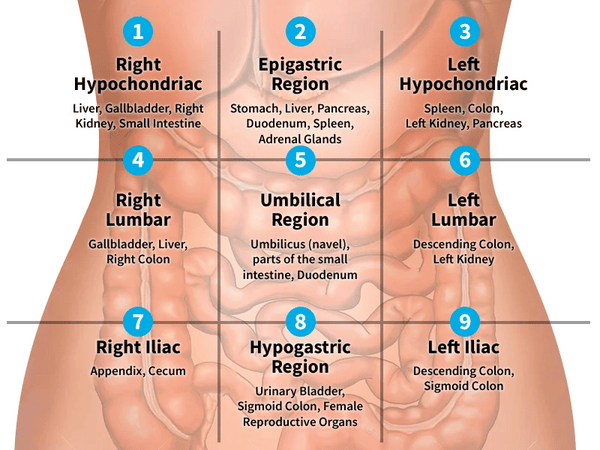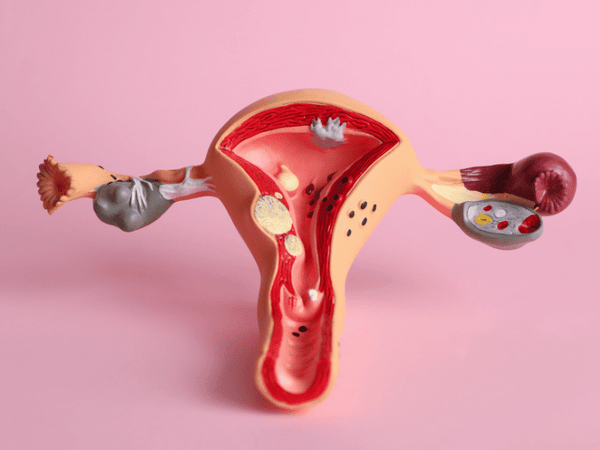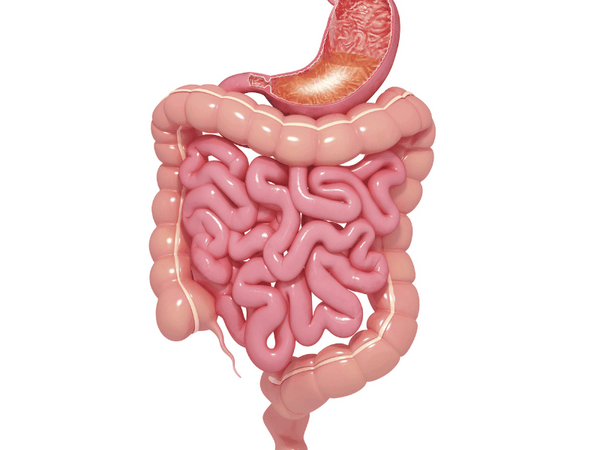Pain in the lower left abdomen near the hip bone can be a concerning and uncomfortable experience, especially for females. It's a symptom that can arise from various underlying causes, ranging from gynecological issues to digestive system problems and musculoskeletal conditions. Understanding the potential reasons behind this pain is crucial for accurate diagnosis and effective treatment.
There are lots of reasons why women of all ages might experience abdominal pain. Lower abdominal pain and discomfort in this area can be particularly worrisome due to the proximity to the female reproductive system and organs and the potential overlap of other symptoms such as menstrual cramps, ovulation pain, ovarian cysts, urinary tract infection, or endometriosis.
However, it is important for women's health to consider a wide range of factors, including both digestive and other urinary tract infections, health, and musculoskeletal function, when evaluating the source of the lower abdominal pain.
In this comprehensive guide, we'll delve into the anatomy of the lower left quadrant of your abdomen and its relationship to the hip bone. We'll explore the common causes of lower abdominal pain, discuss associated symptoms, and outline various treatment options available. Whether you're experiencing occasional discomfort or persistent, chronic pain elsewhere, this resource aims to provide valuable insights to help you better understand your symptoms and make informed decisions about your health.
Let's embark on this journey to unravel the mysteries of lower abdominal pain and discover pathways to relief and recovery.
Lower Left Abdomen and Hip Bone Anatomy

Description of the lower left abdomen and its proximity to the hip bone
Your lower abdomen is the portion that falls under your belly button. The lower left abdomen is a region of the body located between the rib cage and the pelvis, encompassing various organs and structures vital for digestion, reproduction, and musculoskeletal support of abdominal muscles. Positioned on the left side of the body, this area is bordered by the hip bone (iliac crest) and extends towards the lower pelvis.
Key organs and structures
Gynecological Organs

The uterus: A pear-shaped organ where fetal development occurs during pregnancy.
Ovaries: A part of the female reproductive system that is composed of small, almond-shaped glands responsible for producing eggs and hormones like estrogen and progesterone. In the lower left abdomen, one can find the left ovary (in females).
Fallopian tubes: Narrow tubes that transport eggs from the ovaries to the uterus.
Digestive System

Colon: The large intestine, the digestive tract, and small intestine, which absorbs water and nutrients from digested food. Lower right abdominal pain may be related to your appendix, which branches off to the right from your large intestine.
Sigmoid colon: The final segment of the colon, located on the left side of the intestinal wall of the abdomen before the rectum.
Left kidney: Although not directly related to experiencing abdominal pain or other symptoms due to digestion, the left kidney is positioned in the lower left quadrant and left upper quadrant of the abdomen and can sometimes cause abdominal pain.
Musculoskeletal Structures

Hip bone (Iliac crest): The upper curved edge of the pelvic bone, forming the prominence of the hip.
Muscles and ligaments: Various muscles, including the obliques and hip flexors, attach to the hip bone and contribute to movement and stability.
Alive Market Full Spectrum CBD Body Butter
Alive Market Full Spectrum CBD Body Butter offers a soothing solution for individuals experiencing discomfort, such as pain in the lower left abdomen near the hip bone in females. Infused with high-quality full-spectrum CBD, this body butter provides targeted relief by interacting with the body's endocannabinoid system, which regulates various functions, including pain perception. The calming properties of CBD can help alleviate tension and discomfort in the affected area, promoting relaxation and easing discomfort.
Common Causes
Gynecological Causes
Menstrual Cramps
Dysmenorrhea, commonly known as menstrual cramps, can cause lower abdominal discomfort, often radiating toward the hips and lower back. These cramps occur due to uterine contractions during menstruation.
Ovarian Cysts
Cysts are fluid-filled sacs that develop on the ovaries. When cysts rupture or become enlarged, they can cause sharp, localized pain in the lower abdomen near the hip bone. Cysts left in the ovary may result from hormonal imbalances or conditions like polycystic ovary syndrome (PCOS).
Ovarian Torsion
An ovarian torsion is when the ovary and part of the fallopian tube twist, causing the ovary to lose its blood supply.
Endometriosis
Endometriosis is a condition in which the tissue lining the uterus (endometrium) grows outside the uterus, commonly affecting the ovaries, fallopian tubes, and pelvic peritoneum. Lower abdominal pain, especially during menstruation, is a hallmark symptom of endometriosis.
Digestive System Issues
Irritable Bowel Syndrome (IBS)
IBS is a chronic gastrointestinal disorder characterized by abdominal pain, bloating, and changes in bowel habits. Pain in the lower left abdomen near the hip bone may occur as a result of spasms in the colon, especially during periods of increased stress or certain dietary triggers.
Inflammatory Bowel Disease
Inflammatory bowel disease (IBD) is another common cause of stabbing lower left abdominal pain. IBD is a group of conditions that cause inflammation in the digestive tract, including Crohn's disease and ulcerative colitis. Symptoms of IBD include abdominal pain, diarrhea, weight loss, and fatigue.
Diverticulitis
Diverticulitis occurs when small pouches (diverticula) in the colon become inflamed or infected. Left-sided abdominal pain, fever, and changes in bowel habits are common symptoms. In severe cases, diverticulitis can cause localized tenderness near the hip bone.
Constipation
Chronic constipation can lead to discomfort and pain in the lower abdomen, particularly on the abdominal muscles on the left side, where the intestinal wall of the sigmoid colon is located. Straining during bowel movements and infrequent passage of stool may exacerbate symptoms.
Musculoskeletal Causes
Muscle Strain or Injury
Overexertion or sudden movements can strain the muscles in the lower abdomen and hip region, leading to pain and stiffness. Activities such as heavy lifting, vigorous exercise, or improper posture may contribute to muscle injuries.
Hip Joint Problems
Conditions affecting the hip joint, such as digestive and kidney diseases, such as arthritis, bursitis, or labral tears, can also cause pain, and other symptoms manifest as referred pain in the lower abdomen near the hip bone. Discomfort causing pain may worsen with movement or weight-bearing activities.
Pelvic Floor Dysfunction
Dysfunction of the muscles and connective tissues in the pelvic floor can result in pelvic pain and discomfort, which may radiate to the lower abdomen and hips. Pelvic floor physical therapy and relaxation techniques are often recommended for management.
Common Symptoms Experienced by Females
Abdominal Discomfort
-
Dull, achy pain or sharp, stabbing sensations in the lower left abdomen near the hip bone.
-
Discomfort may be intermittent or persistent and may vary in intensity.
Menstrual Irregularities
-
For gynecological causes such as menstrual cramps or endometriosis, ovulation pain may coincide with the menstrual cycle.
-
Changes in menstrual flow, including heavy bleeding or irregular periods, may experience abdominal pain.
Gastrointestinal Symptoms
- The lower abdominal region is mainly filled with small and large intestines, so gastrointestinal issues are the most common cause of this type of pain.
- Digestive system issues like IBS or diverticulitis may present with additional symptoms such as bloating, gas, diarrhea, or constipation.
- Nausea, vomiting, and changes in appetite may also be observed.
Variations in Symptoms Based on Underlying Causes
Gynecological Causes
Menstrual cramps: Pain typically worsens during menstruation and may be accompanied by lower back pain and fatigue.
Ovarian cysts: Pain may be sudden, sharp pain, and more severe pain if a full cyst ruptures, or period pain, accompanied by nausea, vomiting, and fever.
Endometriosis: Period pain may be cyclical and worsen, with additional symptoms like pelvic pain during intercourse and infertility.
Digestive System Issues
IBS: Abdominal pain may be associated with changes in bowel habits, such as inflammatory bowel disease, diarrhea, constipation, or alternating between the two.
Diverticulitis: Pain may be localized and severe, often accompanied by fever, chills, and blood in the stool.
Constipation: Pain may be relieved with bowel movements but can recur if constipation persists.
Musculoskeletal Causes
Muscle strain or injury: Pain may worsen with movement or physical activity and may be accompanied by swelling or bruising.
Hip joint problems: Pain may be felt deep within the hip joint and may worsen with weight-bearing activities or prolonged sitting.
Pelvic floor dysfunction: Lower abdominal pain may be experienced during intercourse, urination, or bowel movements and may be associated with urinary or fecal incontinence.
When to Seek Medical Attention

If you're experiencing lower left abdominal pain between your belly button and pubic bone, it's important to seek medical emergency, prompt and immediate medical care, and evaluation for women's health if experiencing serious conditions like:
-
Severe or worsening abdominal pain that does not improve with rest or over-the-counter pain relievers.
-
Persistent symptoms lasting more than a few days, especially if accompanied by fever, vomiting, or blood in the stool.
-
Symptoms that interfere with daily activities, sleep, weight loss or quality of life.
-
History of underlying medical conditions or previous abdominal surgeries.
Diagnosis and Medical Evaluation
Importance of Consulting a Healthcare Professional
Comprehensive Assessment: Healthcare professionals, such as primary care physicians, gynecologists, gastroenterologists, or orthopedic specialists, play a vital role in conducting a thorough evaluation of lower left abdominal pain near the hip bone. They will consider the individual's medical history, symptoms, and physical examination findings to guide further diagnostic testing.
Differential Diagnosis: Given the diverse range of potential causes for abdominal pain, an accurate diagnosis requires careful consideration of various factors, including age, gender, medical history, and symptom characteristics.
Diagnostic Tests and Procedures Commonly Used
Imaging Studies
Ultrasound: Often the initial imaging modality of choice for evaluating gynecological conditions such as cysts or uterine abnormalities.
Computed Tomography (CT) Scan: Provides detailed images of the abdomen and pelvis, helpful for diagnosing digestive issues like diverticulitis or identifying musculoskeletal abnormalities.
Magnetic Resonance Imaging (MRI): Offers superior soft tissue visualization and is particularly useful for assessing pelvic floor disorders or hip joint problems.
Laboratory Tests
Blood Tests: Comprehensive metabolic panels, complete blood counts, and inflammatory markers may be ordered to assess for signs of infection, inflammation, or hormonal imbalances.
Urinalysis: Helps evaluate kidney function and rule out urinary tract infections or kidney stones, which can sometimes cause referred abdominal pain.
Gynecological Examinations
Pelvic Exam: Allows healthcare professionals to assess the female reproductive organs for abnormalities, such as cysts, fibroids, or signs of endometriosis.
Pap Smear: Screens for cervical cancer and may be performed during a pelvic exam to rule out gynecological causes of pain.
Role of Medical History and Physical Examination
Detailed History: Healthcare providers will inquire about the onset, duration, and characteristics of the pain, as well as any associated symptoms or aggravating factors. Past medical history, including prior surgeries, pregnancies, or pelvic infections, may also provide valuable insights.
Physical Examination: A thorough physical examination may include palpation of the abdomen and pelvic organs, assessment of range of motion in the hips, and evaluation of muscle strength and flexibility.
Treatment Options and Management Strategies
Gynecological Treatments
Hormonal Therapy
For conditions such as menstrual cramps or endometriosis, hormonal medications, including birth control pills, hormone replacement therapy, or gonadotropin-releasing hormone (GnRH) agonists, may help regulate menstrual cycles and alleviate pain.
Surgery
Surgical intervention may be necessary for certain gynecological conditions, such as kidney stones, and serious complications such as ovarian cysts, endometriosis, or fibroids. Procedures like laparoscopy or laparotomy may be performed to move stones, remove cysts, excise endometrial implants, or address structural abnormalities.
Digestive System Management
Dietary Changes and Fiber Intake
Increasing dietary fiber and water intake can help alleviate symptoms of constipation and promote regular bowel movements. Avoiding trigger foods that exacerbate symptoms of IBS, such as high-fat or spicy foods, may also be beneficial.
Medications for Symptom Relief
Over-the-counter or prescription medications, such as antispasmodics, laxatives, or anti-diarrheal agents, may be recommended to manage symptoms of IBS or diverticulitis. Antibiotics may be prescribed for acute diverticulitis episodes.
Musculoskeletal Approaches
Physical Therapy Exercises
Targeted exercises and stretches prescribed by a physical therapist can help improve muscle strength, flexibility, and posture, reducing the risk of recurrent injuries and promoting recovery from musculoskeletal conditions.
Pain Management Techniques
Modalities such as heat therapy, cold therapy, massage, or transcutaneous electrical nerve stimulation (TENS) may provide temporary relief from musculoskeletal pain and discomfort. Nonsteroidal anti-inflammatory drugs (NSAIDs) or muscle relaxants may also be prescribed for pain management.
Integrative and Alternative Therapies
Acupuncture
Acupuncture, an ancient Chinese healing practice involving the insertion of thin needles into specific points on the body, may help alleviate pain and promote relaxation for individuals with chronic or severe abdominal pain and discomfort or musculoskeletal issues.
Yoga and Stretching Exercises
Practicing yoga or engaging in gentle stretching exercises can improve flexibility, reduce muscle tension, and enhance overall well-being. Yoga poses targeting the hips and abdomen, such as child's pose or pigeon pose, may be particularly beneficial.
Lifestyle Modifications and Prevention Tips
Maintaining a Healthy Lifestyle
Balanced Diet: Consuming a diet rich in fruits, vegetables, whole grains, and lean proteins can support digestive health and reduce the risk of gastrointestinal issues like constipation or IBS. Avoiding excessive intake of processed foods, caffeine, and alcohol may also help prevent abdominal discomfort.
Regular Exercise: Engaging in regular physical activity, such as walking, swimming, or yoga, can promote gastrointestinal motility, improve muscle strength, and reduce stress levels. Aim for at least 30 minutes of moderate exercise most days of the week.
Strategies for Preventing Recurrent Abdominal Pain
Stress Management: Practicing relaxation techniques such as deep breathing exercises, meditation, or mindfulness can help alleviate stress and tension, which may exacerbate abdominal discomfort. Consider incorporating stress-reducing activities into your daily routine.
Hydration: Drinking an adequate amount of water throughout the day helps maintain proper hydration and supports healthy digestion. Aim to consume at least 8–10 glasses of water daily, or more if you engage in vigorous physical activity or live in a hot climate.
Tips for Managing Stress and Promoting Overall Well-being
Adequate Sleep: Prioritize getting enough sleep each night, aiming for 7-9 hours of uninterrupted rest. Poor sleep quality or insufficient sleep can contribute to increased sensitivity to pain and worsen other symptoms because of abdominal discomfort.
Mindful Eating: Practice mindful eating by paying attention to hunger cues, eating slowly, and chewing food thoroughly. Avoid overeating or consuming large meals, which can put additional strain on your digestive tract and immune system, and lead to discomfort.
Supportive Relationships: Cultivate supportive relationships with friends, family members, or healthcare providers who can offer encouragement, understanding, and assistance in managing abdominal pain and related symptoms.
Conclusion
In this comprehensive guide, we have explored the complexities of lower left abdominal pain near the hip bone in females, examining its various causes, symptoms, and treatment options. From gynecological issues to digestive system disorders and musculoskeletal conditions, we have highlighted the importance of understanding the underlying factors contributing to lower left abdominal pain and discomfort.
Remember, each person's experience with lower left abdominal pain near the hip bone may be unique, and what works for one individual may not necessarily work for another. Therefore, it's essential to work closely with healthcare professionals to develop a personalized treatment plan tailored to your specific needs and circumstances.
In closing, we encourage you to take charge of your health, listen to your body's signals, and seek professional guidance when experiencing any persistent pain or severe pain symptoms. With the right approach and support, you can overcome your experience of abdominal pain and discomfort and embark on a journey towards optimal health and well-being.


